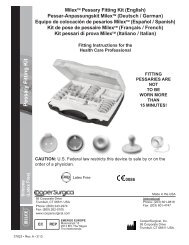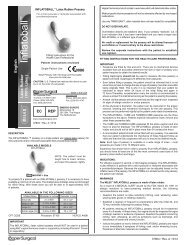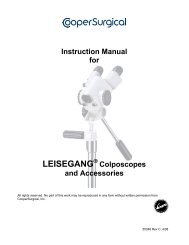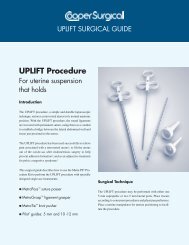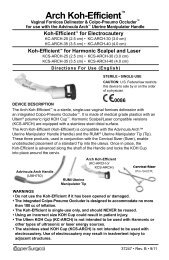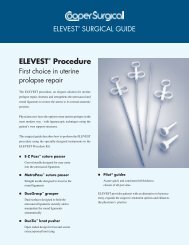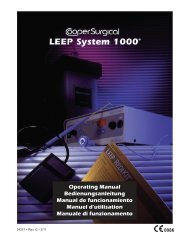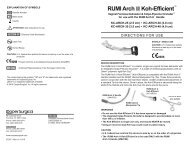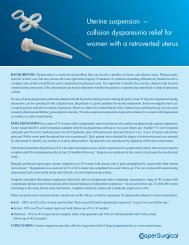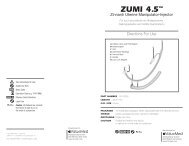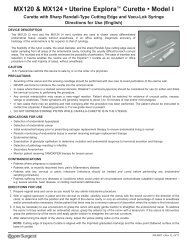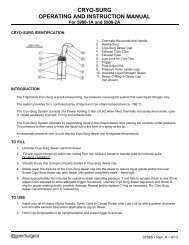LEEP System 1000® Workstation Operating ... - CooperSurgical
LEEP System 1000® Workstation Operating ... - CooperSurgical
LEEP System 1000® Workstation Operating ... - CooperSurgical
You also want an ePaper? Increase the reach of your titles
YUMPU automatically turns print PDFs into web optimized ePapers that Google loves.
5.2 Indications<br />
The <strong>LEEP</strong> procedure is indicated in the diagnosis and treatment of some Cervical Intraepithelial<br />
Neoplasia (CIN) in patients where there is:<br />
• Cytological or colposcopic suspicion of CIN 2 or worse (including micro-invasion)<br />
• Persistent CIN 1 (of more than 12 months duration)<br />
• CIN 1 where the likelihood of follow-up is low or when the patient requests treatment<br />
• A suspicion (cytological or colposcopic) of a glandular intraepithelial abnormality<br />
• A disparity between the cytological and colposcopic diagnoses<br />
• External anogenital lesion<br />
• Large vaginal intraepithelial neoplastic (VAIN) lesions<br />
• Cervical conization indications<br />
5.3 Contraindications<br />
The following are typical contraindications for performing the <strong>LEEP</strong> procedure. It is imperative that the<br />
physician carefully weigh the risks and benefits of treatment versus non-treatment in contraindicated<br />
patients:<br />
• Pregnancy<br />
• Gross invasive carcinoma of the cervix<br />
• A bleeding disorder<br />
• Acute or active inflammation of the cervix, endometrium, fallopian tube, ovary or peritoneum<br />
(cervicitis, endometritis, tubo-ovarian inflammatory disease or pelvic inflammatory disease)<br />
• “Positive” endocervical curettage or a lesion in which the endocervical limit cannot be visualized<br />
colposcopically<br />
• Less than three months postpartum<br />
• Equivocal cervical abnormality<br />
5.4 <strong>LEEP</strong> Procedure and Technique<br />
It is recommended that the patient be provided with a brief description of the procedure and the equipment<br />
that will be used (ACOG, <strong>CooperSurgical</strong> and other professional organizations and equipment manufacturers<br />
have produced patient information brochures on the <strong>LEEP</strong> procedure that address many of the questions and<br />
concerns that your patients may have regarding the procedure).<br />
5.5 Safety Precautions<br />
1. This equipment should only be used by a thoroughly trained physician in an adequately equipped<br />
medical facility.<br />
2. Replacement accessories and patient return pads should be kept on hand since defective active<br />
accessory or patient return pads can result in substandard performance of this equipment.<br />
3. This equipment should only be connected to a properly grounded receptacle. NEVER use an adapter<br />
that defeats the ground of the built-in three (3) prong plug.<br />
4. Care must be exercised when handling liquids around electrical equipment. DO NOT attempt to<br />
operate this equipment if liquids have spilled on the Electrosurgical Generator. DO NOT use<br />
flammable liquids around electrical equipment.<br />
5. This equipment should never be used in conjunction with other equipment for which safety against<br />
leakage current has not been established.<br />
10 <strong>LEEP</strong> <strong>System</strong> 1000 ® <strong>Workstation</strong> • <strong>Operating</strong> Manual



